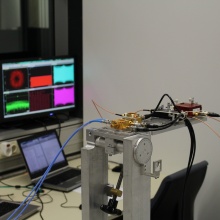Open student theses
Multiple topics available in the satellite project (EIVE) and outdoor, terrestrial transmission to validate the atmospheric effects and characterize the RF E-Band link and modules (EIVE-T project).
Working language: German and/or English.
The options are very diverse, e.g.
- Circuit design (design and layout the prototype PCBs)
- DC supply with voltage and current monitoring
- Adaptive analog lowpass filter design
- System analysis
- data processing to analyze the transmission quality, losses and impairment effects
- influence of the elevation angle on the different transmission parameters, for different modulations and polarizations
- influence of cross-polarization and antenna mutual coupling effects
- Automation by means of integrated microcontrollers
- control the transmission
- adapt to the ambient effects (internal temperature of the antenna housing) as well as the atmospheric effects
- monitor sensors (temperature, pressure, humidity)
- design of a rudimentary interface for digital control
- automatic dynamic antenna positioning and control
- Visualization
- collect, process and visualize the data
- quantify the transmission effects and results.
- FPGA Testing, Verification and implementation of RadHard design.
For details, questions and interests please send an "initiative application" email to the project responsible/ contact person, specifying your interests, experience and expectations.
Please refer to the PDF for more details as well as to the above mentioned projects websites.
Motivation:
Nichtidealitäten elektronischer Schaltungs-komponenten analoger Tx- / Rx-Frontends limitieren signifikant die maximale Übertragungskapazität. Um applikationsspezifisch bereits beim Systementwurf die passenden Schaltungstopologien und Link-Architekturen wählen zu können, ist ein detailliertes Verständnis der Zusammenhänge zwischen Komponenten- und Systemperformance erforderlich.
Ziele:
- Verknüpfung einzelner Nichtidealitäten auf Komponentenebene mit der Leistungsfähigkeit des Gesamtsystems
- Sensitivitätsanalyse verschiedener Link-Architekturen / Schaltungstopologien
Aufgaben:
- Evaluierung vorhandener Entwürfe
- Entwicklung neuer Konzepte
- Circuit-level Simulationen mit ADS
- 3D Feld-Simulationen mit CST/Momentum
- MMIC Layout mit Cadence
- Literaturrecherche
Motivation:
Future back-haul links operating at THz frequencies will be used in wireless communication technologies like 6G and beyond. The required ultra-high data rates in the range of 100 Gbits-1 and beyond are enabled by the H-band (220 – 330 GHz) where large bandwidths are available. One major challenge in wireless THz communication is the increasing free-space path loss (FSPL) as opposed to the achievable maximum output power considering transmit and receive front-ends using solid-state amplifiers. The limited gain of only a couple dBs for patch antennas on chip level as well as 15 to 25 dB for horn antennas on waveguide level prevent large transmission distances for THz wireless communications systems. To improve the directivity of the system larger antennas, for example, Cassegrain antennas with huge reflector diameters, are used to achieve antenna gain in the range of 55 dBi. Major drawbacks are the physical dimensions, heavyweight as well as elaborate handling. A more convenient way with slightly reduced antenna gain is to use collimating lenses instead. The fabrication of such lenses is possible using various materials, e.g. silicon or polymers, in conjunction with fabrication methods like milling or 3D-printing.
Goals:
Design, fabrication and test of a collimating lens suitable for lab-based and outdoor experiments with wireless THz links using waveguide horn antennas and / or on-chip antennas.
Tasks:
- Literature research and evaluation of existing approaches
- Design and simulation of a polymer-based collimating lens
- Fabrication of the developed lens using 3D-print technology
- Test and characterization of the fabricated lens
Motivation:
For a existing wideband Phase Locked Loop (PLL) as part of a carrier recovery, an external, controllable loop filter (LF) must be designed.
It´s application will be in a satellite-groundstation of the EIVE Project, in which it locks on the carrier of an E-band (ca. 75GHz) QPSK-modulated, wideband data
signal. The application only allows fast analog loop filter in the direct path, because
of very small time delay necessary. For accurate tracking of e.g. doppler shift of the moving satellite, temperature shifts etc. an additional, overlaying digitally implemented filter must be developed.
Goals:
- Development of a controllable LF as a mixed signal system (fast analog signal
throughput via OP-Amp, digital implementation (e.g. µ-Controller/
controllable OP-Amp etc.) of slower tracking capability (integration).
- Evaluation of correlation between filter parameters and locking behavior (lock
range, pull in range, stability etc.) of the PLL / carrier recovery.
- Verification of the latter with a functioning prototype of the analog PLL
and the LF.
Tasks:
- Evaluation of required specs for a LF
- Design and simulation of a mixed signal LF
- Design and layout of a prototype PCB
- Design of a rudimentary interface for digital control
- Design of a testbench and debugging of interface
Please refer to the PDF for more details.
Motivation:
The stability of terahertz analog circuits is highly dependent on the quality of the DC supply. MMICs usually require several different DC levels for operation, which must maintain certain ramp-up and ramp-down sequences to avoid damaging the analog circuits. Further, to generate measurements over different operating points, DC voltages must be swept. Measurement automation ensures repeatability and high quality of performed measurements.
Goals:
For the lab power supply of analog integrated circuits Keysight and National Instrument SMUs are used. An interface should be developed to connect the SMUs within an existing environment for measurement automation in MATLAB.
Your Tasks:
- Programming and debugging of a custom software interface / driver library in MATLAB
- Provision of ramp-up and ramp-down sequences
- Validation
- Documentation and creation of user manual
Others:
Form, scope and reimbursement of the student assistant position will be arranged in consultation with the supervisors.
Please refer to PDF for more information.
Research/Master Thesis:
In communication sytems digital predistortion can be used to
enhance the signal quality, while the power amplifier is driven
in saturation. The goal is to research on digital predistortion
algorithms for state of the art THz-Tranceivers
Tasks
• Setup and Implementation of FPGA-based
Sender/Receiver System
• Correlation of sent data and received data in digital
domain. Implementation of real-time control loop for
Sender/Feedback Syncronisation
• Real time analysis of channel performance with digital
algorithms
• Implementation of Real-Time Predistortion Algorithms
without use of external computation („in-loop“)
Goals
• In-loop Predistortion using different DUTs. Experiments
also in E-Band (60GHz – 90GHz) and H-Band (220GHz-
325GHz possible.
• Comparison of In-loop Predistortion using different nonlinear
models with different memory effects.
• Comparison of In-loop Predistortion using different
algorithms
Bachelor thesis/research project:
Communication at 300 GHz is envisioned to become a crucial part in future communication networks. To enhance the datarate and for scalability or reallocation of spectrum resources, channel aggregation is a key element to increase system performance. In this work the student conducts research on channel aggregation in an 300 GHz-Link thorugh combining multiple modems at the IF-Interface of an THz-Link
Tasks
• Evaluation of modem operation without standard housing
• EMV-Performance
• Thermal evaluation
• Combination of multiple modems at E-Band (60-90 GHz) for channel aggregation
• Design of setup, especially combiner and cooling concept. The IF-domain is realized in WR12-waveguide technology.
Goals
• Realization of laboratory experiments with up to eight channels at 300 GHz
• Quantify the impact of parallelization on the systems linearity, because of PAPR-increase
• Formulate/Plan integration in 300 GHz System
Motivation:
Signal linearity in communication systems RF front-ends
is strongly influenced by Power Amplifiers. To
compensate, PAs have to be limited in their output
power (backed-off), to avoid operation in nonlinear
amplification regions. This results in a reduction of
output power thus the PA’s efficiency degrades. Today’s
most promising linearization method is digital
predistortion (DPD). A DPD system requires ADCs for
sampling both the PA’s input and output signal. ADC
sampling bandwidth can be a limiting factor in
processing broadband signals because ADC sampling
bandwidth typically scales with ADC cost.
Goals:
Redesign of a developed observation receiver (OR) for
sampling a 2.5 GHz signal bandwidth based on COTS
components. The OR claims to mitigate the trade-off
between broadband and low-cost. The sampling of
broadband input signals is achieved by downconverting
the signal into multiple narrowband (reducedbandwidth)
frequency windows that are sampled
individually by low-cost ADCs. This allows for broadband
DP without expensive ADCs.
Your Tasks:
• Evaluate existing concepts using systemsimulation
• Redesign of the DPD PCB
• Demonstrating the concept in simulation and
measurements
• Apply DPD algorithms and test the performance on
i.e. E-band amplifiers
Motivation:
Signal linearity in communication systems is strongly influenced by Power amplifiers (PA). Nonlinearities in the PA decrease the signal quality and leads to unwanted spectral regrowth. This behavior can be addressed by linearization techniques such as predistorting the signal in the digital domain (DPD).
In order to implement a realtime DPD for future broadband communications like backhaul or satellite communication, the signal has to be sampled with a high precision over a large bandwidth.
For this scenario, a low-cost observation receiver, based on a spectrum analyzation technique should be implemented and reviewed.
Goals:
The goal is to develop a low-cost spectrum analysis in E-band with existing hardware. Observation of a signal with a minimum bandwidth of 2.5 GHz should be demonstrated.
A theoretical analysis of how to use the concept in future applications is required.
The thesis includes the redesign or reuse of an already developed observation receiver (OR) with commercial of the shelf components and low-cost ADCs.
Your Tasks:
- Experiments on low-cost Spectrum analysis in E-band (60 … 90 GHz)
- Demonstrating the concept in simulation and measurements
- Summarize and quantize the requirements for an OR based on spectrum analyzation
Contact

Dominik Koch
M.Sc.Group Leader Power Electronics / Research Assistant

Benjamin Schoch
M.Sc.Research Assistant


